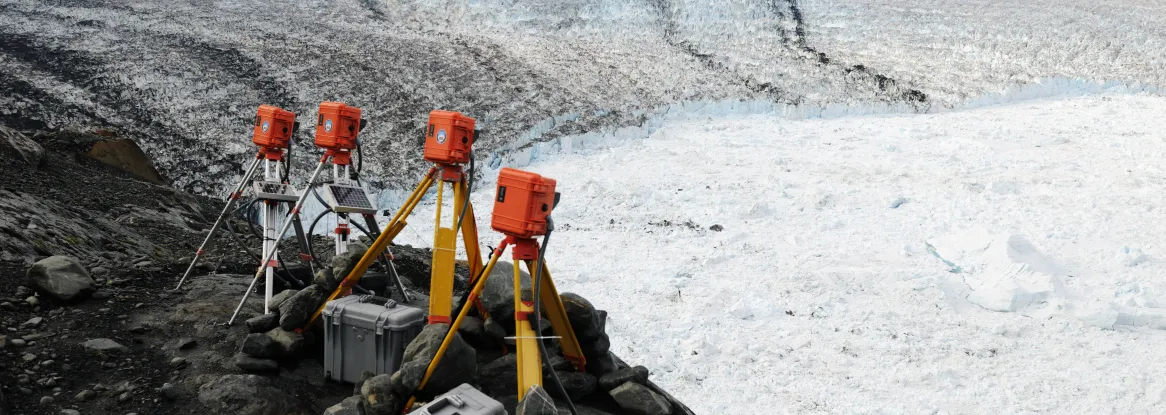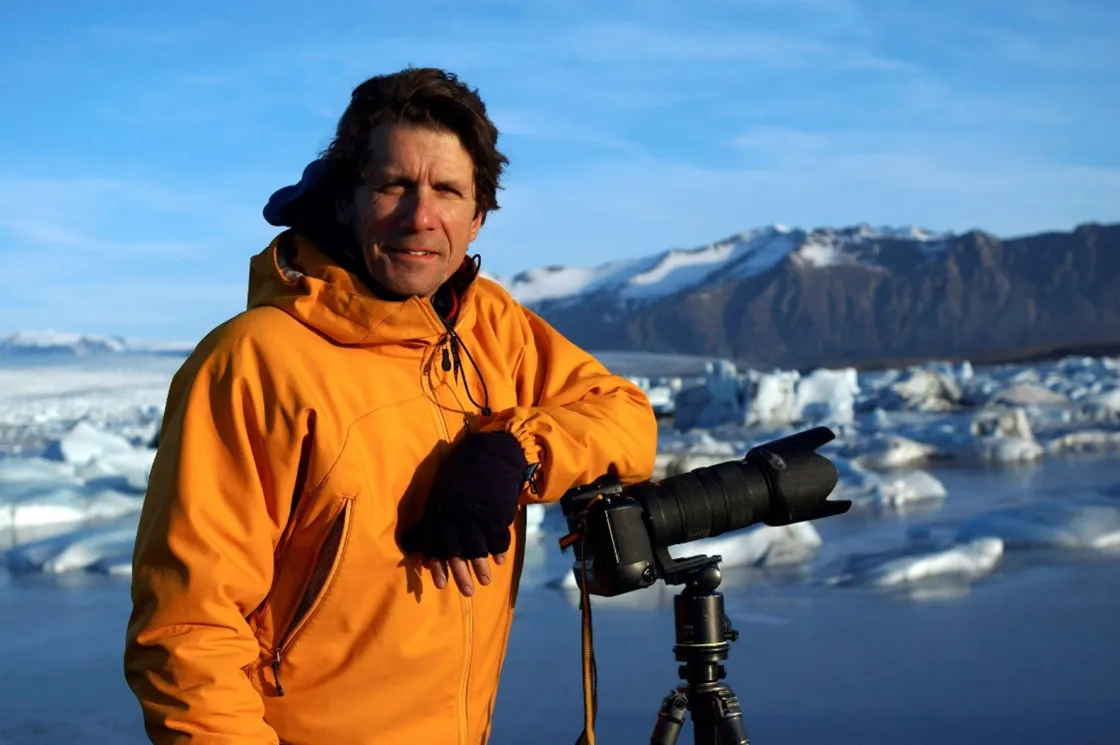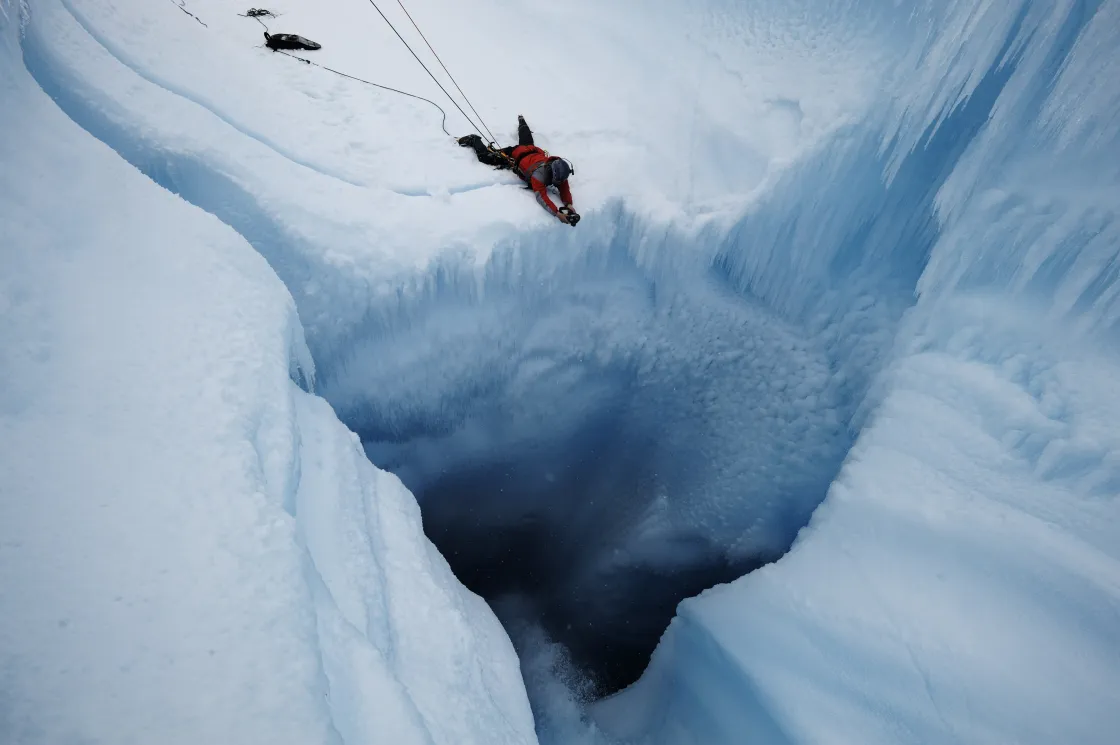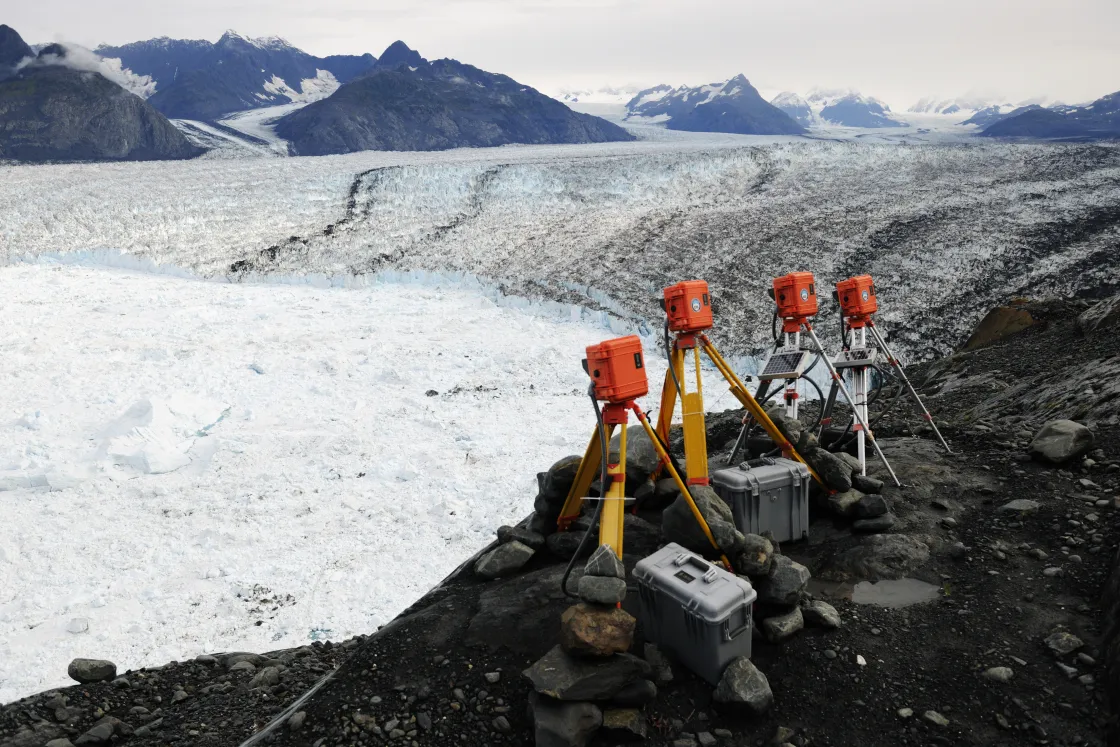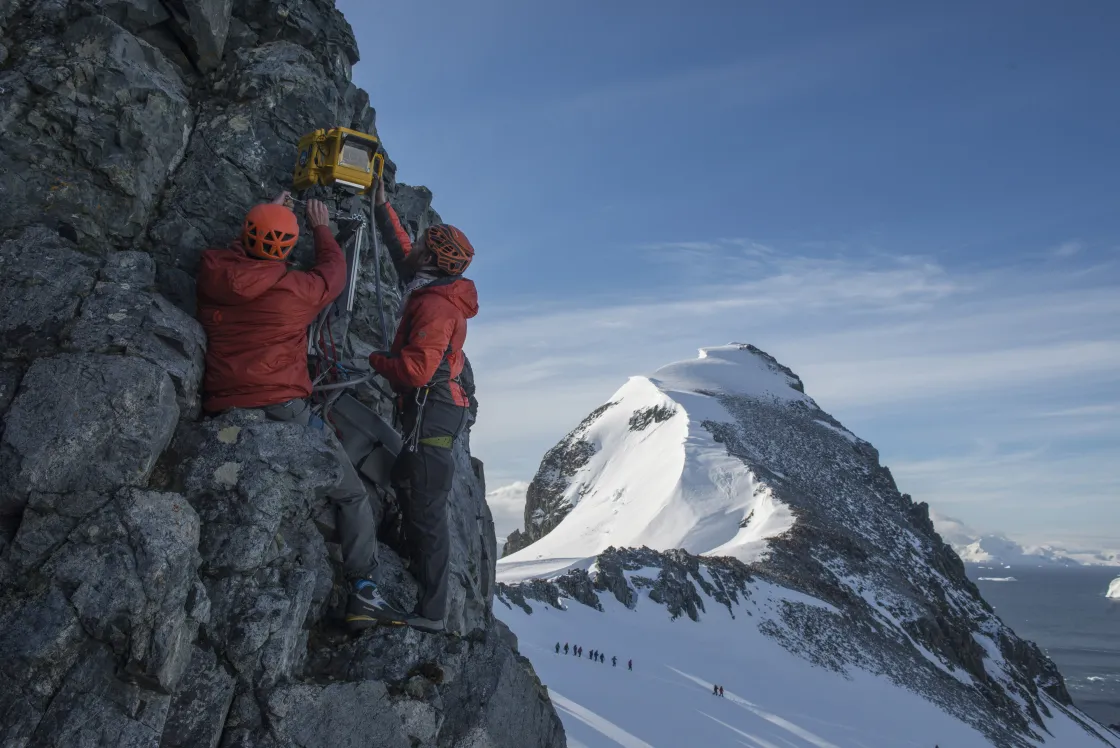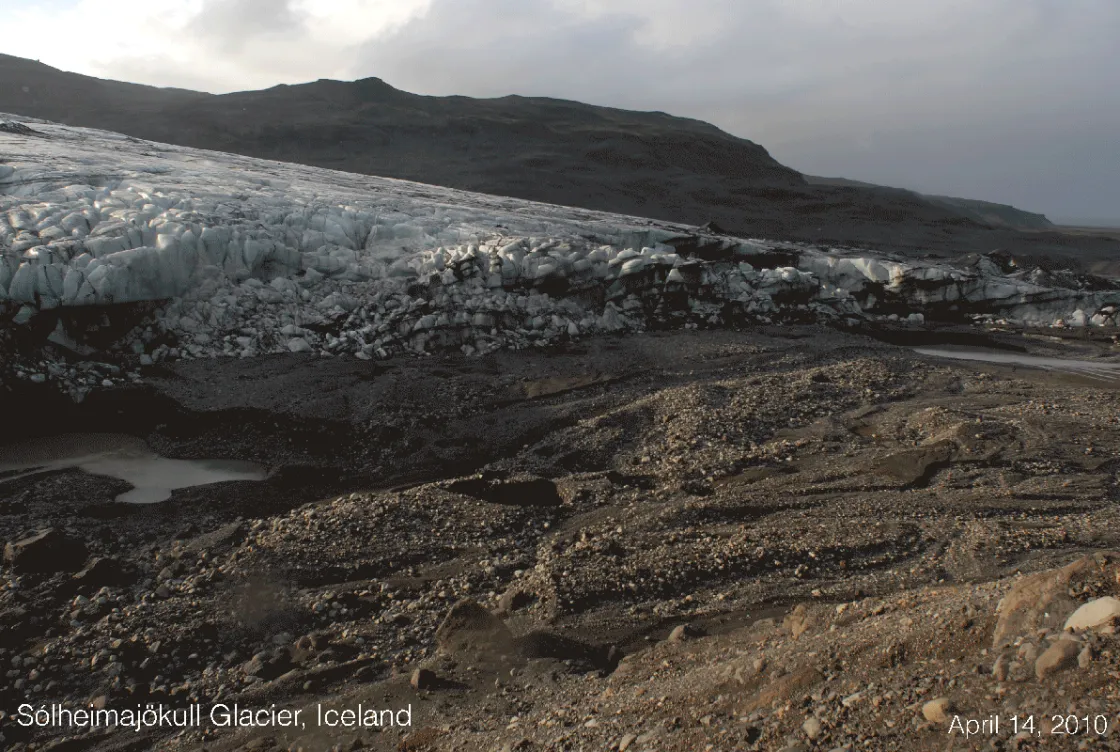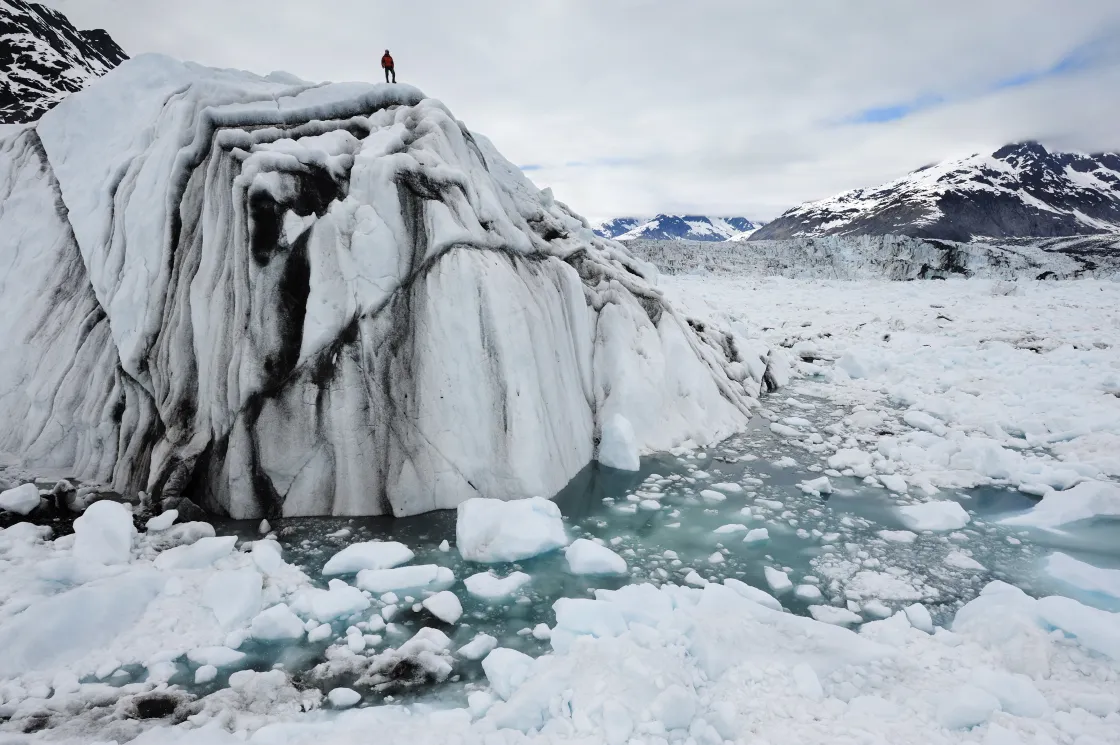By Audrey Payne
From Africa to Alaska to the western United States, people kept telling James Balog, “The weather isn’t what it used to be.” Balog (pronounced “bay-log”), an environmental photographer, mountaineer with a deep background in Earth science, and founder of the Earth Vision Institute in Boulder, Colorado, heard that same sentiment over and over again as he traversed the globe documenting deforestation, endangered wildlife, and the intersection between people and technology. Inspired by legendary twentieth-century photojournalists Robert Capa and W. Eugene Smith, who captured the world’s attention photographing war, famine and poverty, Balog thought photography could also be used to bring eyes to the complex issues facing the natural world.
That repeated observation of the weather would eventually lead to a decade-and-a-half-long project that began in 2007. In that time, Balog would document glacial changes around the world, racking up project costs that, at times, tremendously strained his budget and finances. Eventually, 1.5 million photos showcasing climate change in real time ended up at the National Snow and Ice Data Center (NSIDC). How the project came to be and how the photographs made their way to NSIDC is a long, winding, and fascinating story that unfolded across the cryosphere’s far-flung places and all the way back to his hometown of Boulder.
Following the crumbs of climate change
After hearing others speak about weather changes for years, Balog, an avid mountaineer, backcountry skier, and ice climber, looked to his experiences in Alaska, the Himalayas, and South America, and thought, “Somehow, the story is in the ice.” That was in 1998. With a master’s degree in geomorphology from the Institute for Arctic and Alpine Research (INSTAAR) at the University of Colorado Boulder (CU Boulder), he was well-positioned and connected to investigate and document these changes, if they were indeed occurring. But how?
Balog initially thought about photographing polar bears and penguins, but quickly realized that was severely overworked terrain. “There was nothing left to say there,” he said. But based on his travels in the mountains, he had a strong hunch that the disappearance of glaciers was key to revealing changes in the climate in real time. His first big challenge, though, was to figure out how to visually represent those changes. “As a photographer, you have to go out and experience things,” he said. “You can't just research and write about it. For six or seven years, this issue simmered in my head. I didn’t know what to do with it.”
A call from The New Yorker in 2005 changed everything. Balog was sent on assignment to Iceland to photograph retreating glaciers. There, he got the chance to view several glaciers at the point where they met land or water, otherwise known as their termini. “In so much of my experience, I had seen ice disappearing under piles of glacial rubble,” he said. “Those places aren’t photogenic. They don’t evoke any emotional or aesthetic response. But in Iceland, I saw glaciers where the termini were crumbling and collapsing. And they were very evocative to me photographically.”
Now fully realizing the importance of these frozen photographic subjects, he called National Geographic, a client he had not worked with in 15 years, and asked for funding to photograph a single glacier in Iceland in April and October 2006 to see how it changed. That project quickly turned into a six-month assignment where he wandered the globe chronicling glacier retreat. But the photos still did not tell the full story. “This was single frame photography,” he said. “I was looking at single places in single moments in time and hoping that the pictures carried some sense of change. You had to rely on the caption to give it context, to say this thing is retreating, and this is what's happened over the past years or decades. That didn't seem like enough to me.”
How hard can it be?
As Balog was wrapping up the editing for the National Geographic cover story, “The Big Thaw,” which came out in June 2007, he had a lightbulb moment. He knew he had to go back to see how the glaciers were changing over time. Two weeks later, he started planning to place 25 time-lapse cameras out by the glaciers. “I thought, how hard can it be?” he said. “But I severely underestimated it. I thought it would be a three-year, two-summer project. But that turned into five years, then 10 years, then 15 years. And it came with a lot of challenges.”
To get started, Balog relied on advice and vital funding support from two glaciologists who were chronicling glacial change sporadically in the short-term: Tad Pfeffer from INSTAAR, and Jason Box, who had just left the University of Colorado for Ohio State University. Working off their knowledge, he began building time-lapse systems in custom boxes powered by heavy batteries and solar power. “I was not an electronics technician by a long shot,” Balog said. “And there were a lot of technical details that I had to sort out on my own.”
Balog’s young family even jumped in to help. “Thank goodness I’ve got this incredibly wonderful wife, Suzanne, and my daughters, Simone and Emily, who were very engaged and supportive,” he said. The construction of the equipment took over his garage for several months, and he looks back fondly as he remembers his six-year-old daughter, Emily, assisting. “I often joke that I had the only child in the country who knew what a turnbuckle was,” Balog said, referring to a piece of equipment that he used to adjust tension in cables which secured the cameras.
The birth of the Extreme Ice Survey
When Balog started to build the cameras, the Extreme Ice Survey (EIS) project was born. Eventually, more than 70 time-lapse cameras were placed in the field in Alaska, Glacier National Park in Montana, Iceland, Greenland, Nepal, Austria, Antarctica, Canada, and South Georgia Island. They were programmed to snap continuous shots of glaciers during every hour of daylight for months or years on end. These were the photos that would eventually end up at NSIDC.
In addition to the time-lapse photography, the project also captured beauty shots, which focused on the character of ice, and repeat photographic sequences taken from the same place in successive years using ordinary cameras. These shots, taken from aircraft and the ground, were placed in Canada, Switzerland, Austria, Bolivia, France, and Mount Kilimanjaro in Tanzania. Those images are available at the Library of Congress and in the rare book collections of Cornell and Yale Universities.
When placing the time-lapse cameras in the field, Balog once again tapped into his network of experts. “Most of the time-lapse images in the NSIDC collection were either produced directly by me, or by my field assistants on my payroll and under my direct supervision,” said Balog. “The fundraising was very complicated. The majority of it was from my philanthropic funding efforts with some additional funding from NASA, National Geographic, and National Science Foundation.” A significant fraction of the collection was generated by Jason Box and his team, by then at the Geological Survey of Denmark and Greenland (GEUS). “Jason and the GEUS guys were maintaining weather stations, and they had these very large budgets to get helicopters to go out to some really obscure, difficult places, so they put out a lot of the cameras in the more remote places in Eastern and Northern Greenland.”
During the beginning of the project, Balog did not know if the cameras would capture any change at all. “I thought we’d be lucky to see a little bit of change on a few glaciers,” he said. But he began to see tremendous retreat during the first few months. “We were seeing unbelievable change on almost everything we were looking at. It was stunning,” he said. He began to share the images through lectures, presentations, his website, and the media. “And the world at large kind of lit up with excitement over it. This was the first-ever concrete, tangible, comprehensive, visual evidence of the impact of climate change. It was right in front of your eyes, and it was so powerful.”
Fifteen years of challenges
As the project continued, it was not without challenges. The equipment had to be designed to hold up in severe weather conditions, including 150-mile-per-hour winds at a weather station in Glacier National Park. The power sources, including car batteries, would wear out. A volcano erupted five miles from several of Balog’s cameras in Iceland. “One of the cameras was shooting every half hour, and it happened to catch the cloud of ash just as it’s coming down the glacier. It started to come into the edge of the frame, and the next frame, 30 minutes later, was totally black. You couldn’t see anything.” The ash ruined the camera and it had to be replaced.
There was also a matter of upkeep and clean up. Balog and his team visited many of the camera sites multiple times a year and recruited colleagues to help with other locales. “Nothing was left behind,” said Balog. “Science has a bad reputation for leaving stuff behind on the landscape, and I was very conscious of not doing that, so we made a point of removing every last bit of gear from our field sites.”
Funding, though, was the biggest challenge of them all. Balog estimates that in the 15 years of the project, it cost between six and eight million dollars, and he was constantly working to raise money to carry it forward, which led to a lot of personal stress and financial hardship.
Involving the National Snow and Ice Data Center
A vast collection of glacier time lapse images would eventually be archived at NSIDC as the Extreme Ice Survey (EIS) Glacier Image Archive, 2007-2022, containing 1.5 million images documenting glacial change over the 15 years of the project. Archiving that number of images came with its own set of challenges, and NSIDC’s involvement came in fits and starts, according to Donna Scott, the programs and projects lead at NSIDC who managed the Extreme Ice Survey Project at NSIDC.
In fact, Balog first approached NSIDC a decade ago about archiving the images, while EIS was still ongoing, but at the time, he wanted to restrict access for educational and non-profit use. NSIDC was unable to create a system to limit access to certain types of users, so Scott and Florence Fetterer, the NOAA@NSIDC program lead, reached out to the University Libraries at CU Boulder to see if they could help create a system to manage the images. Unfortunately, those talks were unsuccessful, and NSIDC fell off the project for a time.
Once the Extreme Ice Survey wrapped up in 2022, Balog circled back to NSIDC. “NSIDC was the obvious place to send the photos,” said Balog. “It's the premiere repository of visual ice knowledge in the world and it's a few miles away from my house, so it can't get any better than that.”
Scott spoke with him about open science, the concept that scientific research should be accessible and transparent, and the potential value of making the images available to the public. This time, he agreed to the lack of restrictions. That is when the work truly began for NSIDC.
It takes a village
The first major hurdle for NSIDC was securing funding. “I fought to move this project forward,” said Scott. “When you have a 15-year image gallery showing changes through time, that’s relevant to what we do here. I knew there would be a benefit.”
Scott secured endorsements from the NSIDC science team, many of whom wrote support statements outlining how the images benefited science. Then, Jennifer Kay, a Cooperative Institute for Research in the Environmental Sciences (CIRES) Associate Director and Fellow at the University of Colorado Boulder, and Mark Serreze, the director of NSIDC, stepped up to contribute funding.
With funding secured, the work began to transfer the images, which proved difficult from the start. Balog's team was not equipped with the appropriate systems to push 1.5 million images to NSIDC servers. There were image directories too large to transfer efficiently, and the NSIDC team was unsure if the images received were complete. Scott had to get creative to finish the transfer and ensure a complete collection. She requested an exception to normal business practices for data transfer and recruited a CU Boulder student to download the remaining images.
Like a covert operation, in the NSIDC parking lot, Scott was handed a military ammo box containing Balog's "Archive 2C EIS" hard drive with nearly two million images from the EIS project. The team got to work downloading the remaining images and creating an organizational structure that would provide easier access for a broader community. Reconciliation identified multiple image types, and over 200,000 duplicate images that were removed from the collection. "It took over 60 hours to organize the images, quite a bit longer than we anticipated," said Scott.
This project took a village. Aside from Scott and Fetterer, Ian Stewart, a computer science student, and Blake Graham and Ryan Weber from the NSIDC data operations team supported Balog’s team with the full data transfer, and reconciled and organized the images. Lauren Herwehe, an NSIDC technical writer, produced and published the technical document and image manifest to assist users in accessing the data.
Pushing through the challenges
In late 2023, 16 years after the launch of the Extreme Ice Survey, the time-lapse images from the project were uploaded to NSIDC’s archives, where they are stored, managed, and made accessible to the public for the foreseeable future.
“This project was challenging,” said Scott. “But I think it’s important to have these images out in the public domain, because it's a way to then start showing what is actually happening in the world. Predicting the details of glacier retreat can be difficult for computer models, and this is a valuable resource to improve our understanding. It helps people to understand climate change when you can visually see the change happening.”
When asked why he soldiered on despite the challenges, Balog said, “I believe that in the future, people are going to look back at our time and all of the changes that were happening, and say, ‘What were they thinking? How could they have been so oblivious?’ I want my pictures to tell these people 100 or 200 years from now that some of us were alive and awake with our eyes wide open, and we were paying attention.”
Find the Extreme Ice Survey images here.
Find information on how to access data using an FTP client here.
